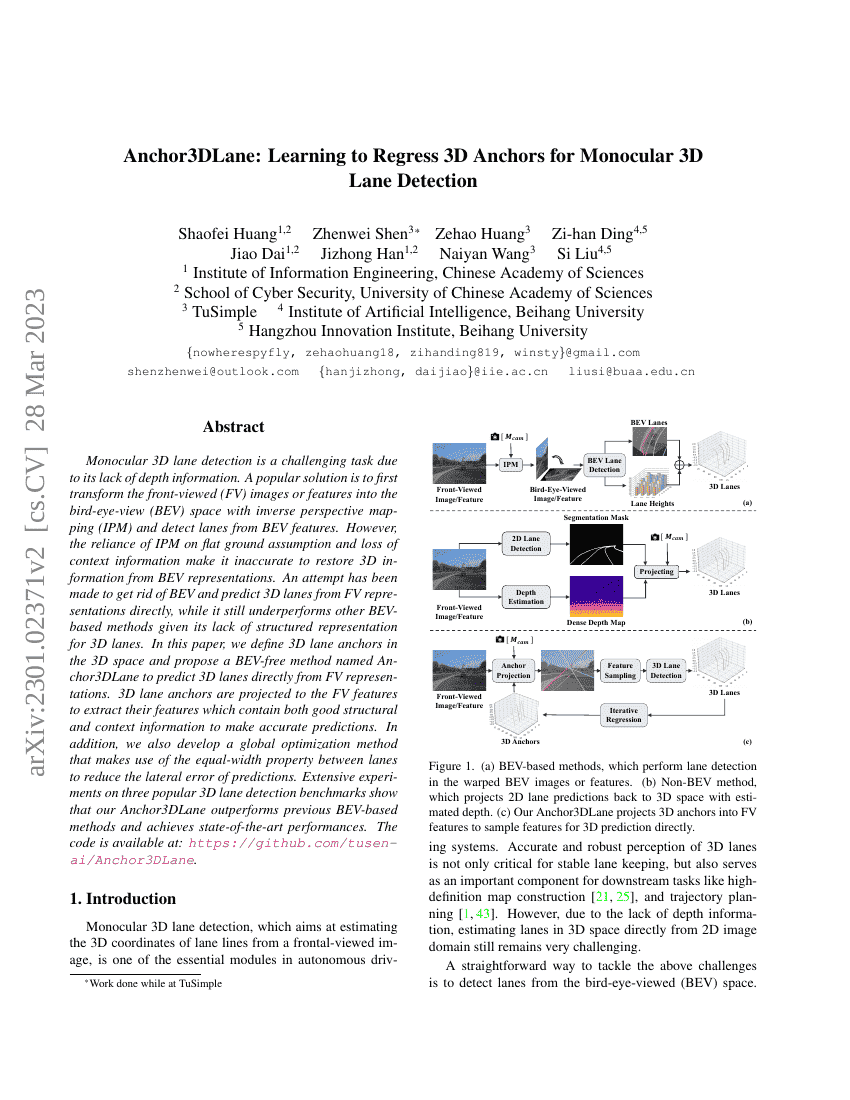
摘要
单目3D车道检测是一项具有挑战性的任务,主要是由于缺乏深度信息。一种常见的解决方案是首先通过逆透视映射(IPM)将前视图(FV)图像或特征转换到鸟瞰图(BEV)空间中,然后从BEV特征中检测车道。然而,IPM依赖于平坦地面假设以及上下文信息的丢失,使得从BEV表示中恢复3D信息变得不准确。已有尝试摆脱BEV,直接从前视图表示中预测3D车道,但由于缺乏结构化的3D车道表示,这种方法的表现仍然不如基于BEV的方法。在本文中,我们在3D空间中定义了3D车道锚点,并提出了一种无需BEV的方法——Anchor3DLane,该方法可以直接从前视图表示中预测3D车道。3D车道锚点被投影到前视图特征上,以提取包含良好结构和上下文信息的特征,从而进行准确的预测。此外,我们还开发了一种全局优化方法,利用车道之间的等宽特性来减少预测的横向误差。在三个流行的3D车道检测基准上的大量实验表明,我们的Anchor3DLane方法优于以往的基于BEV的方法,并达到了最先进的性能。代码可在以下地址获取:https://github.com/tusen-ai/Anchor3DLane。
代码仓库
tusen-ai/anchor3dlane
官方
pytorch
GitHub 中提及
基准测试
| 基准 | 方法 | 指标 |
|---|---|---|
| 3d-lane-detection-on-apollo-synthetic-3d-lane | Anchor3DLane | F1: 95.6 X error far: 0.306 X error near: 0.052 Z error far: 0.223 Z error near: 0.015 |
| 3d-lane-detection-on-apollo-synthetic-3d-lane | Anchor3DLane† (iterative regression) | F1: 95.4 X error far: 0.299 X error near: 0.048 Z error far: 0.220 Z error near: 0.013 |
| 3d-lane-detection-on-openlane | Anchor3DLane† (iterative regression) | Curve: 57.2 Extreme Weather: 52.5 F1 (all): 53.7 Intersection: 45.4 Merge u0026 Split: 51.2 Night: 47.8 Up u0026 Down: 46.7 |
| 3d-lane-detection-on-openlane | Anchor3DLane (ResNet-18) | Curve: 56.2 Extreme Weather: 51.9 F1 (all): 53.1 Intersection: 44.2 Merge u0026 Split: 50.5 Night: 47.2 Up u0026 Down: 45.5 |
| 3d-lane-detection-on-openlane | Anchor3DLane-T† (multi-frame + iterative regression) | Curve: 58.0 Extreme Weather: 52.7 F1 (all): 54.3 FPS (pytorch): - Intersection: 45.8 Merge u0026 Split: 51.7 Night: 48.7 Up u0026 Down: 47.2 |